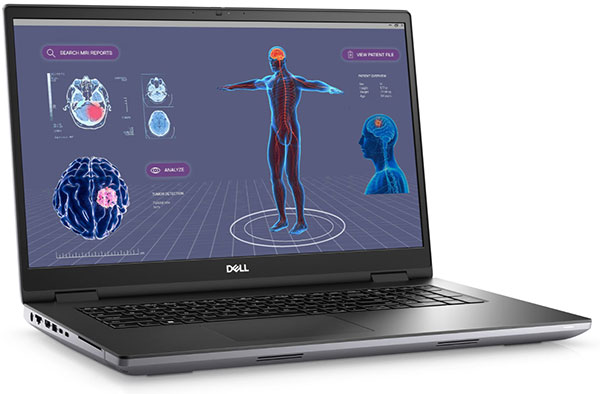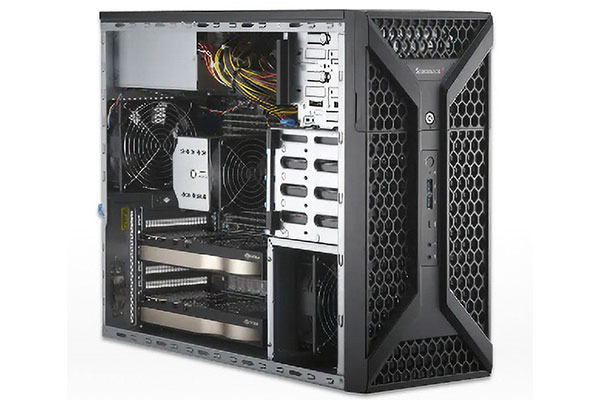Keeping Pace With Needs of Workstation Users
Post-pandemic, engineers and designers want a balance between power and form factor for the newest workstations.

Dell offers its 17-in. Precision 7780 mobile workstation in various configurations, using Intel i7 or i9 Core processors with a choice of NVIDIA mobile GPUs, including its top-line RTX 5000 Ada. Image courtesy of Dell.
Engineering Computing News
Engineering Computing Resources


AMD

Dell

Lenovo

Latest News
December 4, 2023
The past few years have been a rocky road for engineering workstation vendors. Though sales have been better than expected, customer demands shifted rapidly in response to pandemic IT requirements, followed by a post-pandemic requirements reshuffle.
As 2024 approaches, engineers and designers in manufacturing companies, along with their decision-makers, are looking for the right mix of power and form factor in their new workstations. We engaged several vendors and analysts on the current state of the market and what they envision for 2024.
NVIDIA Leads the Charge
More than any specific workstation vendor, graphics hardware vendor NVIDIA is reaping the rewards of the shift to artificial intelligence (AI) and the rise of electric vehicles, two trends that will shape the workstation market in 2024.
In its most recent fiscal quarter, “NVIDIA not just exceeded any and all projections, even its own, but more accurately, crushed them,” says Andy Patrizio with Jon Peddie Research. Generally accepted accounting principles (GAAP) earnings were up 854% from a year earlier, and up 148% from the previous quarter.
To provide some comparative clarity, Patrizio notes, “NVIDIA’s income statement was enviable from top to bottom, but none more so than the gross margin of 70.1%, which is unheard of in the semiconductor space. Intel is struggling just to get to 40%.”
The future looks as rosy as the recent past for NVIDIA’s graphics expertise. “Discrete graphics will continue to be a fundamental technology for many environments,” says Michael McNerney, vice president of security at Supermicro. “The highest performing 3D graphics continue to come from discrete graphics compared to CPU logic. Both single-user CAD and shared, collaborative spaces, such as NVIDIA Omniverse environments, will continue to demand fast and low latency performance from both a centralized server as well as local hardware.”
None of the vendors we spoke to see Intel’s latest venture into discrete graphics processing as having an impact on the engineering workstation market in the near future.
A new generation CPU from Intel, the Intel Core Ultra (a.k.a. Meteor Lake) will ship late in 2023. It will feature an integrated neural processing unit for AI acceleration, and is equipped with Intel Arc, the company’s new discrete graphics processor technology. “The GPU has performance parallelism and throughput, ideal for AI infused in media, 3D applications and the render pipeline,” notes an Intel announcement.
The Return of Desktop Workstations
During the pandemic, sales shifted to mobile workstations. Now the market is emphasizing desktop models again. Engineers and designers are opting for more powerful desktop setups with increased core counts, GPU capabilities and ample RAM, reports Josh Covington, director of sales and marketing at Velocity Micro. This shift is largely attributed to the growing demand for AI, machine learning and high-performance computing (HPC) applications. “As these technologies become increasingly prevalent in various industries, the need for robust desktop workstations is clear,” Covington says.
“The introduction of Intel’s latest generation of processors earlier this year reintroduced a preference for mainstream and high-end desktop workstations,” says Brooks Flynn, director of workstation product management at Lenovo. “The recent announcement of AMD’s new Threadripper Pro will likely reinforce that in the coming quarters.”
The buying trend may be moving back to deskside, but that doesn’t mean every buyer is clambering for more towers. Small form factor (SFF) workstations sales are increasing, as high-performance applications are more common in locations where space is at a premium.
These new use cases are data and graphics intensive. The NVIDIA RTX 4000 SFF Ada Generation graphics processing unit (GPU) is supporting the increased demand, with its ability to support 2 FP32 data paths for CAE and 3D modeling. This unit can support up to four 5K monitors at 60Hz, using mini-DisplayPort connectors. This power is balanced by increased energy efficiency, with a rating of 70W total graphics power.

“All systems from small to large are increasingly challenged to meet competing factors to keep size, cooling and acoustics at acceptable levels,” says Charlie Walker, senior director and general manager for Precision workstations at Dell. “The trend will be slightly larger systems and cooling solutions to meet the demands of improved performance with the right customer experience, specifically acoustics.”
CPU Rivalry Heats Up
Intel’s Alder Lake CPU technology, with its hybrid approach of Efficient (E) cores and Performance (P) cores, has raised questions about its impact on workstation configurations. Vendors say their engineering customers think Intel’s hybrid technology is noteworthy, but in day-to-day use they lean heavily toward the P-cores for their primary applications. E-cores are seen as beneficial for background and heavily threaded applications but are not the primary choice for single-threaded tasks like CAD and modeling.
On the other hand, AMD-based workstations are gaining market share, particularly in the mid-range. Their Ryzen processors, with 3D cache technology, have garnered acceptance among engineering professionals. AMD’s Threadripper CPUs are becoming popular for highly threaded workloads such as CAD, outperforming Intel’s offerings in cost per core.
“On the higher end, Threadripper has been an absolute force with highly threaded workloads,” says Velocity Micro’s Covington. “Intel simply hasn’t been competitive from a cost-per-core perspective with their Sapphire Rapids Xeon line. I see that trend continuing through 2024 and beyond unless Intel makes a major strategy change [which they should].”
Form Factors Adapt to Modern Requirements
The increasing size and power requirements of graphics cards have influenced the preference for workstation form factors. SFF builds have become less common, mainly due to the demands of power-hungry GPUs and the thermal requirements of modern processors. Workstation boards and chipsets are predominantly ATX or larger, and manufacturers are offering fewer SFF options for high-end consumer chipsets. As a result, full tower builds are gaining favor among engineers and designers who require powerful workstations for their tasks.
Nonetheless, vendors offer SFF options, as professionals who eschewed traditional workstations in the past are now interested in the new possibilities found in AI and advanced technical visualization.
GPU Acceleration
GPU acceleration has reshaped the CAE market, with 2023 seeing “one of the bigger spikes in overall professional GPU adoption since NVIDIA originally introduced [compute unified device architectures (CUDA)],” says Covington.
He credits the rise of AI as an engineering tool and the increased use of computational fluid dynamics as key drivers. At the same time, he wonders about long-term success from NVIDIA’s biggest competitor, itself. “The success of [NVIDIA’s] GeForce [consumer-level GPUs] is actually a significant roadblock for NVIDIA in terms of more widespread adoption of professional GPUs, especially in the CAE category. With only a few exceptions, most CAD and CAE applications function just as well—and sometimes better because of higher clocks—on GeForce cards than professional RTX cards.”
Steady Growth for Virtualization
Virtual desktop infrastructure (VDI) is the delivery of desktop computing environments over the internet through virtualization technology. With VDI, users can access their desktop environments from any device with an internet connection, reducing the need for physical hardware and increasing flexibility and scalability. The growth path of VDI in engineering environments has been slow and steady in recent years, a trend that is expected to continue.
“VDI is essential for many industries and environments,” says Supermicro’s McNerney. “Yes, there is a significant demand for servers and workstations that use the GPU to accelerate what is needed for VDI. There may be cases where a workstation equipped with GPUs can deliver low-latency performance to the ‘owner’ and provide VDI environments for other users. The software would have to be able to split up the tasks to different GPUs and scheduling software to maintain low latencies.”

There have been times when a company hits the brakes on VDI and other forms of centralization not because of performance issues but because of cooling issues. The most powerful CPUs and GPUs run hot; too much consolidation becomes a power consumption issue.
All AI All the Time? Hardly
Looking ahead, AI looks to become a major disruptive force in the workstation market. Digitalization, developments in real-time rendering such as NVIDIA Omniverse, electric vehicle and autonomous driving trends, and remote collaboration technologies are expected to shape the future workstation landscape.
Vendors all noted Intel’s interest in discrete graphics, but the ball is clearly in NVIDIA’s court when performance counts the most.
It looks like 2024 will be marked by a continued shift toward powerful, mostly desktop-based workstations. Form factors are adapting to meet contemporary requirements, and the industry remains focused on performance, reliability and the integration of advanced technologies into workflows.
More AMD Coverage

More Dell Coverage

More Intel Coverage
More Jon Peddie Research Coverage
More Lenovo Coverage

Subscribe to our FREE magazine, FREE email newsletters or both!
Latest News
About the Author
Randall S. Newton is principal analyst at Consilia Vektor, covering engineering technology. He has been part of the computer graphics industry in a variety of roles since 1985.
Follow DE



